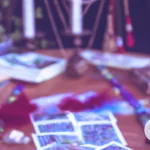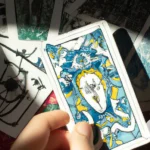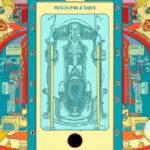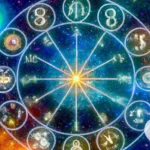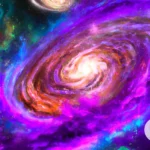The world is full of mysteries that have long fascinated human beings. From the movement of the planets to the patterns of our dreams, there are endless questions to explore. Among the many ancient arts of divination, numerology and tarot have shone their light through the centuries, offering glimpses into our innermost selves. But what do these practices really mean, and how do they work? How can we use them to gain deeper understanding of ourselves and our place in the world? To explore these questions, we’ll delve into the intricate connections between numerology, tarot, and Jung’s theory of synchronicity. Join us on this journey of revelation and self-discovery.
Numerology and Tarot
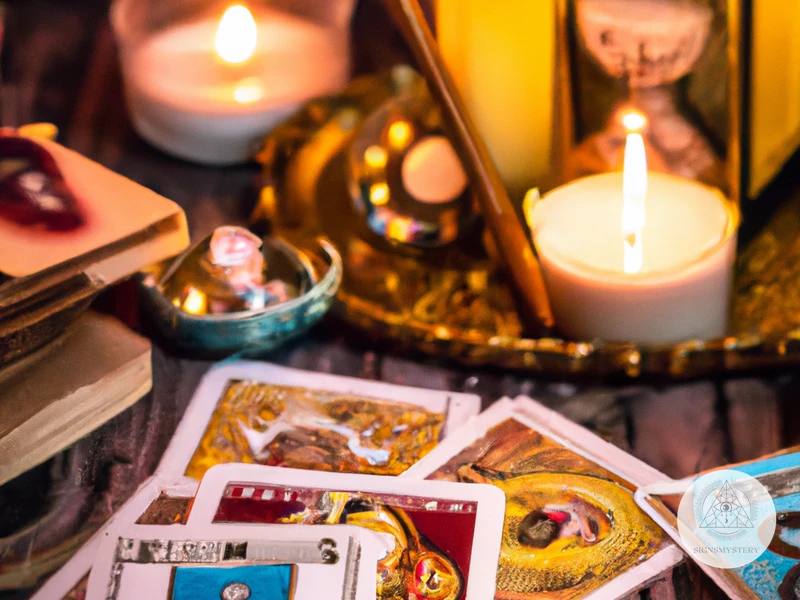
When it comes to divination, Tarot reading and numerology are two powerful tools that can assist with self-discovery and guidance. The relationship between these two practices has been explored extensively by both amateurs and professionals in the field. Numerology involves examining the mystical significance of numbers and how they relate to specific characteristics and energies, while Tarot card reading involves the use of archetypes and symbolisms to gain insight into the present and future. Understanding how these practices intersect can enhance your Tarot reading and uncover new layers of meaning. In this section, we will explore the basics of numerology and Tarot and how they connect. For a deeper look into Tarot’s connection to Jungian psychology like the collective unconscious, shadow self, and more, check out our article on Tarot Archetypes and Jungian Psychology.
What is Numerology?
Numerology is the study of the symbolic meaning of numbers, and how these numbers relate to our lives and the universe. As Carl Jung believed, numbers play an important role in human psychology and our collective unconscious. Numerology uses numbers to help gain insight into a person’s personality traits, strengths, weaknesses, and potentials.
In numerology, numbers are reduced to a single digit by adding their individual digits together. For example, the number 143 would be reduced to 8 (1+4+3=8). Each number has a specific meaning and significance. These meanings can be used to interpret various facets of our lives, including character traits, life paths, and even compatibility with others.
In the context of tarot cards, numerology is used to give additional insight into the meanings of the cards. Each card in the tarot deck is assigned a number, which can be used to enhance the interpretation of the card. For example, the number 1 is associated with new beginnings and potential, so a card with the number 1 may represent a new opportunity or the start of a journey.
Numerology allows us to better understand the meaning and significance of numbers in our lives and how they relate to our personalities and journeys. By incorporating numerology into tarot card readings, we can gain even deeper insight into ourselves and the world around us. To learn more about the connection between Carl Jung and tarot card readings, check out this article on our website.
What are Tarot Cards?
Tarot cards are a set of cards typically used for divination, which is the practice of seeking knowledge of the future or unknown through supernatural means. They have a rich history and are deeply rooted in both divination and spiritual practices. Tarot cards consist of 78 cards that are separated into two parts: the Major Arcana and Minor Arcana.
The Major Arcana consists of 22 cards that represent major life events, insights, and turning points. The Minor Arcana consists of four suits – Swords, Pentacles, Cups, and Wands – each containing 14 cards. The cards are numbered one through ten, with four additional Court cards: King, Queen, Knight, and Page. The Court cards represent people in the querent’s (person receiving the reading) life, while the cards numbered one through ten represent situations, events, and energies.
Tarot cards have been a popular tool for self-discovery, introspection, and spiritual development. The use of Tarot cards can help people explore their innermost thoughts and emotions. Many psychologists, notably Carl Jung, have integrated Tarot cards into their therapeutic practices. Jung believed that the Tarot was a symbolic representation of the collective unconscious, and that the archetypes represented in the cards could be used to help people better understand themselves and their place in the world.
Some believe that Tarot cards can be used to access the shadow self, which is the hidden and often repressed parts of the psyche. From a Jungian perspective, the unconscious mind is divided into two distinct parts: the personal unconscious and the collective unconscious. The personal unconscious contains repressed memories and trauma, while the collective unconscious contains archetypes that are universally shared among all people.
Tarot cards can be interpreted in many different ways, each with their own unique interpretations and symbolism. For those interested in a Jungian interpretation, there are many resources available that explore the connection between Tarot cards and the collective unconscious. By embracing the symbolism and imagery present in Tarot cards, one can explore the mysterious depths of the psyche and gain a deeper understanding of themselves and the world around them.
Numerology in Tarot Cards
Numerology in Tarot Cards plays a significant role in Tarot readings. Every card in the Tarot deck has a unique number associated with it. These numbers are believed to hold spiritual significance and can reveal hidden meanings in a reading. The following table shows the numbers associated with the Major Arcana cards in a standard Tarot deck:
| Card Number | Card Name |
|---|---|
| 0 | The Fool |
| 1 | The Magician |
| 2 | The High Priestess |
| 3 | The Empress |
| 4 | The Emperor |
| 5 | The Hierophant |
| 6 | The Lovers |
| 7 | The Chariot |
| 8 | Strength |
| 9 | The Hermit |
| 10 | Wheel of Fortune |
| 11 | Justice |
| 12 | The Hanged Man |
| 13 | Death |
| 14 | Temperance |
| 15 | The Devil |
| 16 | The Tower |
| 17 | The Star |
| 18 | The Moon |
| 19 | The Sun |
| 20 | Judgment |
| 21 | The World |
In numerology, each number has a unique vibration and energy that can be interpreted in different ways. For example, the number 1 represents new beginnings and leadership, while the number 2 represents balance and partnership. By understanding the numerology of Tarot cards, readers can gain deeper insights into the spiritual meanings behind each card and how they relate to an individual’s life journey.
Understanding the numerology of Tarot cards is particularly important when conducting a reading. The numbers of the cards drawn can provide insight into a person’s current situation, their strengths and weaknesses, and potential obstacles or opportunities. By combining the meanings of the Tarot cards with their corresponding numerology, readers can provide a more accurate and insightful reading for their clients.
Now that we understand the importance of numerology in Tarot cards, let’s dive deeper into the Jungian theory of synchronicity and how it connects to both numerology and Tarot.
Jung’s Theory of Synchronicity
As we delve into the world of numerology and tarot, we come across the enigmatic concept of synchronicity. This idea was first introduced by Swiss psychologist Carl Jung, who believed that events and experiences in our lives are connected in ways that defy conventional notions of time and causality. Understanding Jung’s theory of synchronicity is crucial to fully grasping the interplay between numerology and tarot. Thus, we’ll explore the intricacies of this concept and how it relates to the world of tarot and the collective unconscious.
What is Synchronicity?
Synchronicity, as defined by Swiss psychologist Carl Jung, is the experience of two or more events that are apparently unrelated or unlikely to occur together by chance, yet are experienced as occurring together in a meaningful manner. This concept suggests that events are connected through the collective unconscious, or a shared human experience and understanding beyond our individual consciousness.
Jung believed that the study of synchronicity could lead to a deeper understanding of the human condition and psyche. He argued that traditional scientific methods of cause-and-effect explanations are not sufficient to explain experiences that lack clear causal relationships.
For instance, when we ask a question to the Tarot, the cards that appear to us may not necessarily have a clear relationship or explanation for their presence but can provide a meaningful message. This message is not just the result of chance but may come as an answer to our deeper, unspoken questions.
Synchronicity is also closely linked with the concept of numerology in Tarot cards. It suggests that the numbers appearing on the cards are not just random but can help us to better understand our own experiences, decisions, and personal growth.
In Jungian interpretation, the Tarot is a tool for self-discovery and personal development, and synchronicity provides the connection between the meanings of the cards and our own understanding of ourselves and our lives. When interpreting the Tarot, we should pay attention not only to the individual symbols on the cards but also to the numbers and patterns that emerge from them.
To learn more about the connection between Tarot, synchronicity, and the Jungian interpretation, you can visit this article or join the discussion at the Tarot Collective Unconscious.
How it Connects to Numerology and Tarot?
Synchronicity is a crucial concept in connecting numerology and Tarot cards. It was introduced by the famous Swiss psychologist Carl Jung, who believed that there are meaningful coincidences that cannot be explained by cause and effect or by chance. Jung’s theory of synchronicity suggests that these coincidences are the result of a deeper, more spiritual connection between the mind, the universe, and the collective unconscious.
In the context of numerology and Tarot, synchronicity connects these practices by suggesting that the numbers, symbols, and images found in Tarot cards are meaningful and significant beyond their physical appearance. Every card in a Tarot deck has a specific meaning and is associated with a particular number. These numbers can be used to interpret the cards and gain a deeper understanding of their message.
The connection between numerology and Tarot is further strengthened by the fact that both practices are based on the belief that everything in the universe is connected and that there is a deeper meaning and purpose to our lives. Numerology suggests that the numbers that appear in our lives, like birthdays and phone numbers, can reveal deeper truths about our personalities, our strengths and weaknesses, and our life’s purpose. Similarly, Tarot cards can provide insights into our subconscious and reveal hidden truths about ourselves and our lives.
By using numerology and Tarot together, we can gain a deeper understanding of the universe and our place in it. The numbers in Tarot cards can be interpreted through the lens of numerology, allowing us to understand the deeper significance behind the images and symbols on the cards. Similarly, synchronicity can help us interpret the messages that the Tarot has for us, allowing us to gain insights that may not be immediately apparent.
If you’re interested in exploring the connections between numerology, Tarot, and synchronicity further, check out our article on Tarot and self-discovery through a Jungian lens.
Numerology and Synchronicity in Tarot Spreads
As we delve deeper into the world of tarot, we begin to realize that there is so much more to it than just drawing cards and interpreting meanings. Tarot enthusiasts often explore other divinatory practices to enhance their readings, such as numerology and synchronicity. Combining these practices can provide a more holistic understanding of the messages that the cards hold. In this section, we will explore the fascinating connection between numerology, synchronicity, and tarot spreads, and how to apply them to your own practice.
Using Numerology to Enhance Your Tarot Reading
Numerology can be a valuable tool when it comes to enhancing your tarot reading. By assigning numerical values to the tarot cards, you can gain a deeper understanding of their meanings and the messages they hold. Here are some ways you can incorporate numerology into your tarot reading:
- Assigning Numerical Values to the Tarot Cards: Each tarot card has a numerical value that corresponds to its position in the tarot deck. For example, the Ace of Cups has a value of one, the Two of Cups has a value of two, and so on. By understanding these numerical values, you can gain a deeper understanding of the significance of each card in your reading.
- Creating Numerological Tarot Spreads: You can also create tarot spreads based on numerology. For example, a three-card spread can represent the past, present, and future, while a five-card spread can represent the five elements of nature (earth, air, water, fire, and spirit). These spreads can provide a more comprehensive look at the energies at play in your life.
- Interpreting Numerologically Significant Numbers: Certain numbers have special significance in numerology, such as the number seven representing spirituality and the number nine representing completion. When these numbers show up in your tarot reading, it can offer further insight into the energies at play in your life.
- Calculating Life Path Numbers: You can also use numerology to calculate your life path number, a number that represents your life’s purpose and journey. This number can offer insight into the lessons you are here to learn and the challenges you may face.
- Combining Numerology with Other Divination Tools: Finally, you can also combine numerology with other divination tools, such as astrology or runes, to gain a deeper and more holistic understanding ofthe energies at play in your life.
Subscribe to Our Newsletter
Sign up to receive the latest news and updates.
Incorporating numerology into your tarot practice can enhance your understanding of the messages and energies present in your readings. Combining numerology with other divination tools can provide even greater insight into the intricacies of your life’s journey.
Synchronicity in Tarot Spreads
Synchronicity plays a significant role in tarot spreads, as it helps to establish a meaningful link between the numerological significance of the cards and the querent’s real-life experiences. The idea is that the universe presents a set of circumstances or events for the querent to consider, which are reflected in the tarot cards.
What does this mean for tarot spreads?
When creating a tarot spread, the reader can use numerology to select a specific set of cards that relate to a particular number or sequence, such as the Fibonacci or Pythagorean sequences. By doing so, they can tap into the synchronistic nature of the universe and provide the querent with an insight into how their experiences align with this sequence.
How does synchronicity manifest in larger tarot spreads?
In larger tarot spreads, synchronicity may manifest in the form of repeated numbers, patterns or themes. A skilled reader can use these repetitions to build a more in-depth understanding of the querent’s situation, looking beyond the surface level interpretation of individual cards and instead, addressing the overarching themes that underpin the spread.
How can a tarot reader use synchronicity to enhance their interpretations?
By understanding the role of synchronicity in tarot readings, a reader can gain insights that might not have otherwise been revealed by the cards themselves. For example, if a spread contains several cards with the number 5, the reader might consider that the number 5 represents change and instability. They could then use this insight to explore the spread in more depth, looking for ways in which the querent might benefit from embracing change and adapting to new situations.
Ultimately, synchronicity is a powerful tool that can help tarot readers to unlock the full potential of their spreads, providing a deeper understanding of the universe’s intentions and the querent’s experiences within it.
Examples of Numerology and Synchronicity in Tarot Spreads
Tarot spreads can be enhanced by the use of numerology and synchronicity to provide deeper insights into a person’s life. Let’s take a look at some examples of how numerology and synchronicity can be used in tarot spreads.
Example One:
For this spread, the numerology aspect is based on a person’s life path number. The life path number is calculated by adding up the digits in a person’s birthdate. For example, if someone was born on May 27th, 1985, their life path number would be 1+9+8+5+0+5+2+7= 37, which reduces to 3+7=10, 1+0=1.
The spread would consist of five cards, and each card would represent a specific aspect of the person’s life path. For example:
- Card one: Represents the person’s strengths and talents according to their life path number.
- Card two: Represents potential obstacles or challenges the person may face in their life path.
- Card three: Represents the person’s current path and what they should be focusing on in their life.
- Card four: Represents potential areas of growth and development for the person.
- Card five: Represents the ultimate outcome of the person’s life path.
Example Two:
In this spread, synchronicity is used to connect the cards based on their symbolism and meaning. The focus is on the connections between the cards and how they relate to the question being asked.
For this spread, three cards would be drawn. The first card represents the past, the second card represents the present, and the third card represents the future. Each card is then analyzed for its symbolic meaning and how it connects to the other cards. For example:
| Card One – Past | Card Two – Present | Card Three – Future |
|---|---|---|
| The Tower | Temperance | Death |
| The past was characterized by a dramatic upheaval or crisis (The Tower). This led to a period of balance and harmony (Temperance) in the present, but the future may bring significant change or transformation (Death). | The present is a time of patience and moderation, where the person is learning to balance different aspects of their life, but they may soon face a major transition. | The future will require the person to let go of the old and embrace the new, which may be difficult but ultimately transformative. |
Example Three:
For this spread, the numerology aspect is based on the use of a specific number. The number represents a specific theme or question, and the cards drawn will relate to that theme.
In this example, the number is 7. Seven is associated with spiritual growth, intuition, and wisdom. Seven is also a number of completion and cycles. For this spread, seven cards are drawn, and each card represents a different aspect of the theme of spiritual growth. For example:
- Card one: Represents the person’s current level of spiritual understanding.
- Card two: Represents potential barriers or challenges the person may face on their spiritual journey.
- Card three: Represents what the person needs to let go of in order to progress spiritually.
- Card four: Represents the person’s strengths and talents that can aid them on their spiritual journey.
- Card five: Represents potential areas of growth and development for the person.
- Card six: Represents what the person needs to embrace in order to progress spiritually.
- Card seven: Represents the ultimate outcome of the person’s spiritual journey.
These examples illustrate how numerology and synchronicity can be used in tarot spreads to provide a deeper level of insight and understanding. By being mindful of these concepts, tarot readers can create more detailed and meaningful readings for their clients.
Conclusion
In conclusion, it is important to note that numerology and synchronicity can greatly enhance your tarot reading. By understanding the meanings behind numbers and their connection to the tarot, you can gain deeper insights into the messages the cards are trying to convey. Additionally, by focusing on synchronistic events that occur during your reading, you may be able to tap into a universal flow of energy and gain valuable information from the cards.
While Jung’s theory of synchronicity is still controversial in some circles, it is clear that there is much overlap between numerology, tarot, and the concept of meaningful coincidences. Whether you believe in a higher power guiding your readings or simply see the connections between symbols and archetypes, incorporating numerology and synchronicity into your tarot practice can lead to more profound and impactful readings.
In order to effectively incorporate these concepts into your tarot practice, consider taking the time to study numerology and its connection to the tarot. By familiarizing yourself with the meanings behind different numbers and their relevance to tarot card interpretations, you can deepen your understanding and improve your readings. Additionally, keep an open mind to the idea of synchronicity and pay attention to meaningful coincidences that occur during your readings. By staying present and attuned to spiritual energies, you can uncover insightful information that may have otherwise gone unnoticed.
Overall, the use of numerology and synchronicity can greatly enhance your tarot readings and facilitate a deeper connection with the messages the cards are trying to convey. Whether you are a seasoned tarot reader or just starting out, incorporating these concepts into your practice can provide a greater sense of meaning and insight into the world around you. So take the time to explore the connections between numerology, tarot, and synchronicity, and see where this knowledge can take you on your spiritual journey.
Frequently Asked Questions
What is the origin of numerology?
Numerology has roots in ancient cultures, including China, Egypt, and Greece.
Can numerology predict the future?
Numerology is not used to predict the future, but rather to gain insight and understanding of oneself and their life path.
What are the major arcana cards in tarot?
The major arcana cards in tarot are a set of 22 cards, each with a unique symbol and meaning, that represent major life events or universal archetypes.
Can tarot cards reveal specific details about the future?
Tarot cards are not meant to be used for fortune-telling or revealing specific details about the future, but can provide guidance and insight into one’s current situation.
What is the significance of repeating numbers in numerology?
Repeating numbers, such as 11:11 or 777, are considered to hold special significance in numerology and can indicate a message from the universe or higher power.
What is the shadow self in Jungian psychology?
The shadow self in Jungian psychology is the unconscious part of the psyche that contains repressed or denied aspects of the self, including traits or behaviors considered unacceptable or undesirable.
How can synchronicity be used in tarot readings?
Synchronicity can enhance tarot readings by providing meaningful coincidences or connections between the cards and the querent’s life experiences or emotions.
Can tarot cards be used for self-reflection?
Tarot cards can be a powerful tool for self-reflection and gaining insight into one’s subconscious thoughts and emotions.
What are some common numerology calculations used in tarot readings?
Common numerology calculations used in tarot readings include the life path number, personal year number, and numerology chart calculations based on the letters in one’s name.
How can tarot readings be used for personal growth?
Tarot readings can facilitate personal growth and self-awareness by providing insights into one’s emotions, motivations, and potential paths for growth and development.



